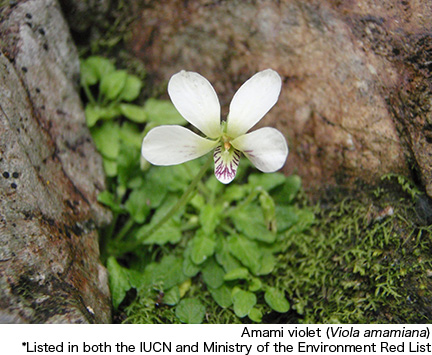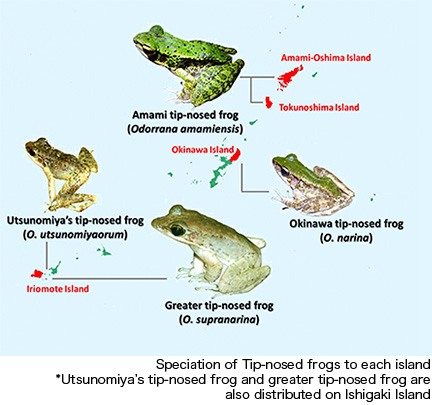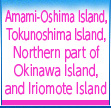- Ministry of the Environment>Nature & Parks>
- World Natural Heritage in Japan>
- Amami-Oshima Island, Tokunoshima Island, Northern part of Okinawa Island, and Iriomote Island>
- Outstanding Universal Value
Outstanding Universal Value

- An important area for biodiversity conservation, with many internationally rare endemic species due to unique biological evolution reflecting the process of formation of the islands
Rich biodiversity
Although the area of the World Heritage property covers less than 0.5% of Japan’s land area, it supports a large proportion of the fauna and flora in Japan. For example, there are 1,819 vascular plants that account for 26% of the total vascular plant species in Japan, about 740 terrestrial and inland water vertebrates (57%), and about 6150 insect (21%).
The fauna and flora of the property includes 95 globally threatened species listed in the IUCN Red List and more than 540 threatened species listed in the Red List of the Ministry of the Environment, Japan.
In addition, many endemic species which are only found here are distributed. In particular, a high rate of endemism is observed for terrestrial mammals (62%), terrestrial reptiles (64%), and amphibians (86%), and all of the freshwater crab species of Potamonidae are endemic to the area. The area is therefore extremely important for the biodiversity conservation.
Although the area of the World Heritage property covers less than 0.5% of Japan’s land area, it supports a large proportion of the fauna and flora in Japan. For example, there are 1,819 vascular plants that account for 26% of the total vascular plant species in Japan, about 740 terrestrial and inland water vertebrates (57%), and about 6150 insect (21%).
The fauna and flora of the property includes 95 globally threatened species listed in the IUCN Red List and more than 540 threatened species listed in the Red List of the Ministry of the Environment, Japan.
In addition, many endemic species which are only found here are distributed. In particular, a high rate of endemism is observed for terrestrial mammals (62%), terrestrial reptiles (64%), and amphibians (86%), and all of the freshwater crab species of Potamonidae are endemic to the area. The area is therefore extremely important for the biodiversity conservation.

Unique biological evolution reflecting the process of formation of the islands
The species richness, and large number and high proportion of threatened species and endemic species, are all interrelated and have resulted from the geological history of the Ryukyu Chain. The Ryukyu Chain was once an eastern margin of the Eurasian Continent, but tectonic movements caused separation from the Continent, forming an archipelago of small islands. The terrestrial species there became isolated on small islands and went through the unique processes of evolution. For this reason, many examples of endemic species in this area are clearly shown in non-flying terrestrial vertebrate groups and plants that were not able to cross the straits with ease.
Among the endemic species, "relict endemic species" and "new endemic species" are representative of the biological evolutionary processes that reflect the formation of the islands. The Ryukyu long-haired rat and Amami rabbit are representative of relict endemic species that were once widely distributed on the Continent and other areas, but were isolated to the islands of the Ryukyu chain and have survived, retaining their ancient forms, even after their ancestor species on the Continent became extinct. New endemic species, on the other hand, are those that have evolved to adapt to their respective island environments, such as ground geckos and tip-nosed frogs.
The species richness, and large number and high proportion of threatened species and endemic species, are all interrelated and have resulted from the geological history of the Ryukyu Chain. The Ryukyu Chain was once an eastern margin of the Eurasian Continent, but tectonic movements caused separation from the Continent, forming an archipelago of small islands. The terrestrial species there became isolated on small islands and went through the unique processes of evolution. For this reason, many examples of endemic species in this area are clearly shown in non-flying terrestrial vertebrate groups and plants that were not able to cross the straits with ease.
Among the endemic species, "relict endemic species" and "new endemic species" are representative of the biological evolutionary processes that reflect the formation of the islands. The Ryukyu long-haired rat and Amami rabbit are representative of relict endemic species that were once widely distributed on the Continent and other areas, but were isolated to the islands of the Ryukyu chain and have survived, retaining their ancient forms, even after their ancestor species on the Continent became extinct. New endemic species, on the other hand, are those that have evolved to adapt to their respective island environments, such as ground geckos and tip-nosed frogs.








